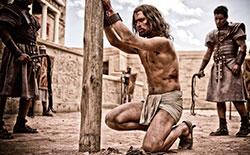Son of God offers different perspectives and an opportunity

Diogo Morgado stars in a scene from the movie Son of God. The Catholic News Service classification is A-III—adults. The Motion Picture Association of America rating is PG-13—parents strongly cautioned, some material may be inappropriate for children under 13. (CNS photo/Fox)
Reviewed by Natalie Hoefer
Let me cut to the chase. Do I suggest seeing the film, Son of God? Yes.
The movie is a compilation of scenes portraying the life of Jesus pulled from last year’s televised miniseries “The Bible” on the History Channel, which was produced by the husband-wife team of Mark Burnett and actress Roma Downey.
The film is a CliffsNotes version of Christ’s ministry, Passion and Resurrection, with the Apostle John serving as the occasional narrator.
Given the subject matter, there are no surprise twists to the plot, and for those who saw the miniseries, the film itself will be a re-run (save for the inclusion of a few scenes deleted from the miniseries).
So why see it if you know the outcome or have already viewed most of the scenes via “The Bible” miniseries?
I offer three reasons: 1) to consider some alternative perspectives of historical characters; 2) to support the Christian film industry; and 3) to start conversations with those who may have fallen away from the Church or those who have questions about Christianity.
I was pulled in by many of the characters. Several were portrayed in such a way as to make me consider their perspective in a new light.
The Apostle John, for instance, played by Sebastian Knapp, seems to always be smiling. He is referred to in the Gospels as “the disciple whom Jesus loved,” but in the movie you get a sense that he, too, adores Jesus.
Simon Kunz portrays the Pharisee Nicodemus, who comes across as torn between the life he leads as a Pharisee, and the new life he sees offered by Christ and his teachings.
I saw in the character of Caiaphas, played by Adrian Schiller, a man whose efforts to eliminate Christ stemmed not so much from a sense of threat to his authority as from one who feared for the negative impact on Jerusalem’s Jewish community in falling for what he perceived to be a false prophet. His motivation seemed to come from a fear of Pontius Pilate preventing the most holy of Jewish feasts, the Passover, which he mentioned many times in the film as a real and unthinkable possibility.
One final character with a strong portrayal was Pilate, played by Greg Hicks. Historians speak of Jerusalem being a detested assignment for a Roman prefect. Hicks’ portrayal of Pilate captures the bitterness the ruler feels for the post, and the internal conflict he feels in dealing with the call for Christ’s death.
Ironically, the characters I found least impressive were Jesus and Mary, played by Diogo Morgado and Roma Downey, respectively.
Morgado’s portrayal comes across as “Fabio Jesus”—his background as a model might have something to do with that—and Downey seemed to lack depth as Mary.
Now, reason two for seeing Son of God. In a world of movie choices that range from immature humor to the most morally offensive of themes, seeing this film sends a message to Hollywood that, “We want more Christian films.”
The timing of the film’s release just before Lent is, while perhaps monetarily strategic, still appropriate. The film sets the Christian mind to the season we’re entering and that which should be foremost in our lives: Christ’s love for us, and striving to live out his call to us as disciples, spreading his message of salvation.
The film provides an opportunity to do just that—evangelize, which is the third reason I recommend seeing it.
Watch it with a Bible study group or small Church community, sure—but also see it with a nominal or fallen-away Catholic, or someone unevangelized in the Christian faith. While the movie—or any movie on Christ’s life—will not likely cause an instant conversion, it is a springboard for conversation about Christianity and Catholicism. It is a tool to spark interest, initiate dialogue, and let the Holy Spirit work from there.
While I do encourage Catholics to see this film, please note that it has a rating of PG-13 stemming from violence portrayed in the Passion and Crucifixion scenes—though the depictions are not nearly as graphic or intense as those from Mel Gibson’s 2004 film, The Passion of the Christ.
One final suggestion: Don’t see this film in a theater that offers dinner-and-a-movie. It was distracting and almost callous when, as the Crucifixion of our Lord played out on the big screen—that crucial moment of the ultimate, saving sacrifice of love—a waitress blocked my view and asked for my credit card. Bit of a mood-killer, that.
(Natalie Hoefer is a reporter for The Criterion, newspaper of the Archdiocese of Indianapolis.) †
